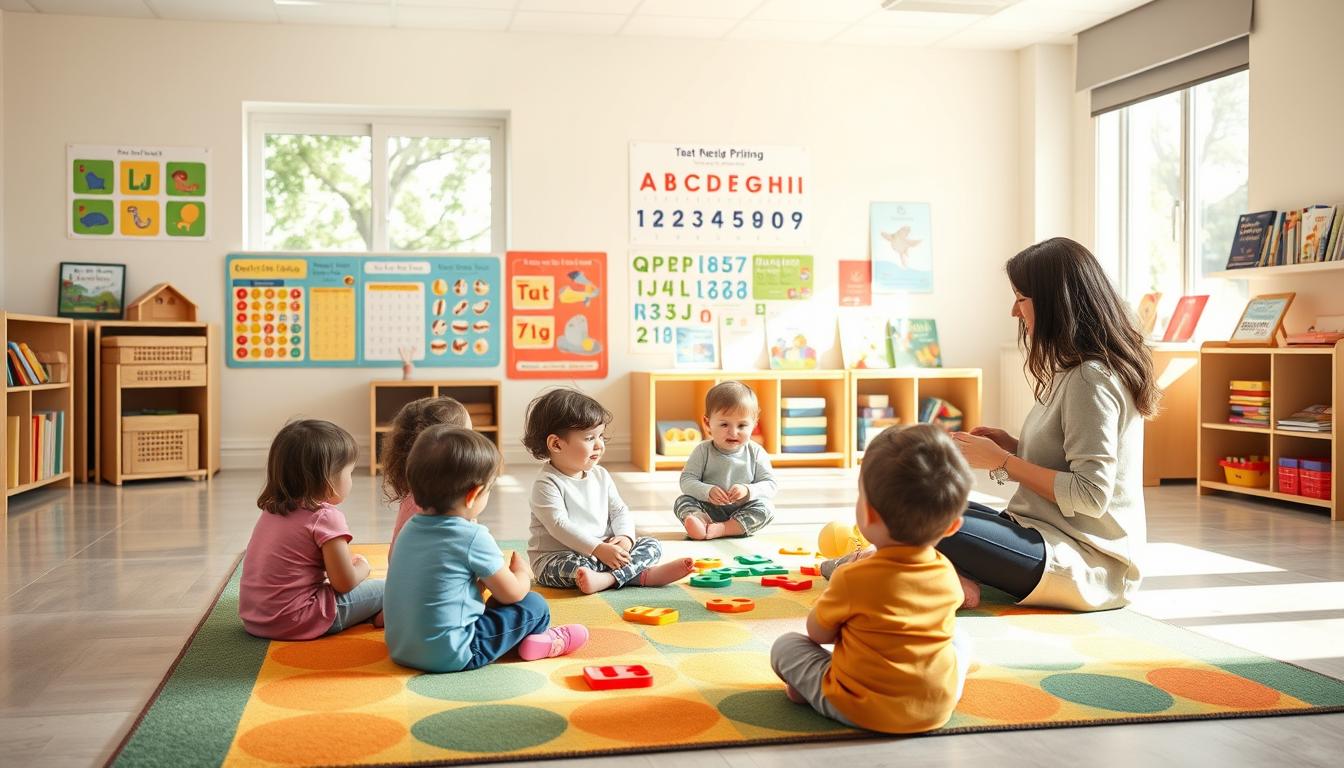Teaching Letters and Numbers to Preschoolers at Home
Did you know that 90% of a child’s brain develops by age 5? This makes the early years a critical time for building foundational skills. But how can we make learning letters and numbers engaging and stress-free for young minds?
At home, play-based activities can transform learning into a fun and interactive experience. From sticky notes with letters to educational toys, small steps can lead to big achievements. These methods not only help preschoolers grasp concepts but also spark curiosity and creativity.
By integrating simple strategies into daily routines, parents can create a nurturing environment that supports both academic and social-emotional growth. Let’s explore how to make this journey enjoyable and effective for your child.
Getting Started with Preschool Learning at Home
Every child learns at their own pace, and understanding this is key to fostering growth. By observing their interests and abilities, we can create a supportive environment that encourages curiosity and confidence.
Understanding Your Child’s Learning Needs
Every kid has unique learning demands. Some may thrive with hands-on activities, while others prefer visual or auditory methods. As parents or teachers, it’s important to observe and adapt to their style.
Start by noting what captures their attention. Do they enjoy storytelling, puzzles, or building blocks? Use these preferences to tailor activities that make learning engaging and effective.
Creating a Structured Daily Routine
A structured day helps kids feel secure while exploring new concepts. Design a schedule that balances learning, play, and rest. For example, dedicate specific times for reading, counting, and creative activities.
Set up designated zones in your home for different activities. A quiet corner for reading, a play area for games, and a workspace for crafts can mimic a classroom environment. This structure helps manage transitions during the day and keeps kids focused.
| Activity Type | Structured Learning | Unstructured Play |
|---|---|---|
| Time Allocation | 20-30 minutes | Free play, no time limit |
| Examples | Alphabet games, counting exercises | Building blocks, imaginative play |
| Benefits | Builds focus and skills | Encourages creativity and independence |
By combining structured learning with free play, we can create a balanced routine that supports both academic and social-emotional growth. This approach ensures kids have the time and space to learn and explore at their own pace.
Engaging Activities for Letters and Numbers
Engaging activities make mastering letters and numbers fun and effective. By blending play with learning, we can create experiences that spark curiosity and build foundational skills. These methods not only help kids grasp concepts but also keep them excited about learning.
Interactive Alphabet Songs and Games
Interactive alphabet songs are a great way to introduce letters. Singing along to catchy tunes helps kids recognize letters effortlessly. For example, the classic “Alphabet Song” can be paired with actions or visuals to enhance engagement.
Hands-on games, like letter matching with plastic Easter eggs, make learning tactile and fun. These activities reinforce letter recognition while encouraging creativity and fine motor skills.
Fun Number Puzzles and Counting Activities
Number puzzles and counting exercises turn math into a playful adventure. Simple activities, like sorting beans or counting toys, help kids understand numbers in a hands-on way.
Incorporating art into these lessons, such as drawing numbers with colorful markers, adds a creative twist. This approach keeps kids engaged while solidifying their understanding.
| Activity Type | Letters | Numbers |
|---|---|---|
| Examples | Alphabet songs, letter matching | Counting toys, number puzzles |
| Benefits | Improves letter recognition | Builds counting skills |
| Materials | Plastic eggs, sticky notes | Beans, toys, markers |
By integrating these activities into daily routines, we can create a balanced approach to learning. This ensures kids develop skills while enjoying the process.
Proven Strategies for teaching preschool basics at home
Creative approaches can turn everyday moments into valuable learning opportunities. By blending play with structured activities, we can help children grasp essential skills in a fun and engaging way. These methods not only reinforce foundational concepts but also spark curiosity and creativity.
Integrating Play-Based Learning
Play-based learning transforms routine skills into exciting adventures. For example, using building blocks to teach counting or letter magnets to introduce the alphabet makes learning interactive. These activities help kids understand abstract ideas through hands-on practice.
Incorporating storybooks into playtime also supports language development. Reading aloud and discussing the story encourages kids to express themselves and build vocabulary. This approach fosters both literacy and communication skills.
Utilizing Art and Hands-On Tools
Art supplies like crayons, markers, and clay simplify complex concepts. Drawing numbers or creating letter shapes with clay makes learning tactile and memorable. These activities also enhance fine motor skills and creativity.
Hands-on tools, such as puzzles and counting beads, provide multisensory experiences. For instance, sorting beads by color or size helps kids practice counting while developing critical thinking. These methods ensure holistic development by merging structured learning with creative play.
- Use storybooks to support language and literacy skills.
- Incorporate art supplies to simplify abstract concepts.
- Engage kids with hands-on tools like puzzles and counting beads.
- Combine structured activities with free play for balanced development.
By integrating these strategies into daily routines, we can create a nurturing environment that supports both academic and social-emotional growth. For more tips on structured online learning programs, visit our pre-school resources.
Interactive Reading and Writing Exercises
Building early literacy skills starts with interactive reading and writing exercises. These activities not only help children recognize letters and words but also foster a love for storytelling and learning. By incorporating fun and engaging methods, parents can create a strong foundation for future academic success.
Exploring Phonics Through Storytime
Storytime is a powerful way to introduce phonics and word recognition. Reading aloud with children encourages them to connect sounds with letters. Choose books with repetitive phrases or rhymes to make the experience engaging.
Interactive sessions, where kids predict outcomes or create alternative endings, enhance comprehension. This approach also builds communication skills as children express their thoughts and ideas. For more ideas, explore our reading and writing activities.
Creative Writing and Tracing Practices
Creative writing activities, like tracing letters or drawing, help children develop hand-eye coordination. Use thick markers, crayons, or unlined paper to make the process enjoyable. These activities also encourage kids to express themselves through words and images.
Multisensory experiences, such as writing in sand or clay, make learning tactile and memorable. These practices reinforce letter shapes and motions, preparing children for more advanced writing tasks.
- Use themed books to capture children’s interest during storytime.
- Encourage kids to write captions for their drawings to connect words with meaning.
- Incorporate multisensory tools like sand or clay for hands-on learning.
- Engage in daily reading and writing exercises to reinforce skills.
By integrating these strategies, parents can create a nurturing environment that supports literacy development. These activities not only prepare children for school but also spark a lifelong love for reading and writing.
Hands-On Math and Science Explorations
Exploring math and science through hands-on activities can ignite a child’s curiosity and love for learning. By using everyday materials, we can create meaningful experiences that make abstract concepts tangible and fun. These activities not only build foundational skills but also encourage critical thinking and problem-solving.
Counting, Shapes, and Measurement Activities
Counting everyday objects, like toys or buttons, helps children understand numbers. Shape sorting and pattern recognition activities enhance spatial awareness. For example, set up a simple activity where kids sort blocks by color or size.
Measurement activities, such as comparing lengths or using measuring cups, introduce concepts like volume and size. These hands-on tasks make math engaging and relatable. Other activities include tracing shapes or creating patterns with beads.
Simple Science Experiments at Home
Science experiments can be both safe and exciting. Try mixing baking soda and vinegar to create a fizzy reaction. This simple experiment teaches cause and effect while sparking curiosity.
Encourage children to share their observations and describe what they see. This fosters communication skills and emotional engagement. Other experiments include growing plants from seeds or exploring buoyancy with water and objects.
| Activity Type | Math | Science |
|---|---|---|
| Examples | Counting toys, shape sorting | Baking soda experiment, plant growth |
| Materials | Blocks, beads, measuring cups | Baking soda, vinegar, seeds |
| Benefits | Builds number sense, spatial skills | Encourages curiosity, critical thinking |
By incorporating these activities into daily routines, we can create a balanced approach to learning. This ensures children develop essential skills while enjoying the process. Hands-on explorations in math and science lay the foundation for lifelong curiosity and discovery.
Building Communication and Social Skills
Developing communication and social skills early sets the stage for lifelong success. Beyond academic knowledge, these abilities help children navigate relationships, teamwork, and everyday interactions. By fostering these skills in a nurturing environment, we prepare them for kindergarten and beyond.
Encouraging Expression Through Play
Play is a powerful tool for encouraging verbal and non-verbal expression. Activities like role-playing or storytelling allow children to share their thoughts and feelings. For example, using puppets or toys can help shy kids express themselves more comfortably.
Structured play, such as group games, promotes interaction and turn-taking. These activities mimic classroom dynamics, teaching children to listen and respond respectfully. Simple games like “Simon Says” or “Pass the Ball” are great for practicing these skills.
The Role of the Preschool Teacher
A preschool teacher plays a vital role in facilitating social and emotional growth. They model positive behavior, guide group activities, and create opportunities for every child to participate. Their support helps children build confidence and learn to communicate effectively.
Group Play and Confidence Building
Group play ensures every child practices speaking in front of peers. Activities like show-and-tell or collaborative art projects encourage participation. These moments not only build confidence but also teach children to respect others’ ideas.
Integrating fun, playful moments into daily routines enriches communication skills. For instance, singing songs or playing charades can make learning enjoyable. These activities help children express themselves while fostering a sense of belonging.
- Use role-playing to encourage verbal and non-verbal expression.
- Incorporate group games to promote interaction and turn-taking.
- Support children’s confidence through show-and-tell or collaborative projects.
- Integrate playful activities like singing or charades to make learning fun.
Strong social skills form a crucial foundation for kindergarten readiness and future academic interaction. For more tips on enhancing communication skills, explore our Spoken English course.
Conclusion
A balanced mix of play and structured activities fosters early learning success. By integrating interactive games, reading, and hands-on explorations, we create a nurturing environment that supports growth. Structured routines and clear communication ensure children feel secure while exploring new concepts.
Every child benefits from a diverse approach that combines fun with learning. Activities like letter recognition, shape sorting, and counting games make abstract ideas tangible. These methods not only build foundational skills but also spark curiosity and creativity.
We encourage parents and teachers to implement these strategies consistently. Celebrate every milestone and adapt resources to meet individual needs. By doing so, we prepare children for kindergarten and beyond, ensuring they thrive academically and socially.







